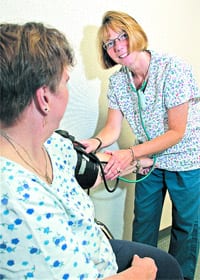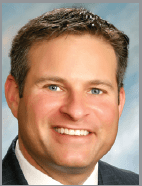Heart of the Matter – Ventricular-assist Device Offers New Answers in Cardiac Care
Q: I just heard about a Springfield man with heart failure who underwent a new procedure at Baystate Medical Center called VAD. Can you tell me about it? My sister has heart failure.
A: A ventricular-assist device (VAD) is a mechanical pump that is used for patients who have reached advanced heart failure. The VAD is surgically implanted in a sac around the heart known as the pericardial space, and helps the left ventricle pump blood to the rest of the body.
The pump is connected directly to the heart at the bottom left ventricle, where it draws blood through the aorta and allows it to flow throughout the rest of the body. A driveline, connected to the pump, exits the body through an opening in the abdomen and is connected to the controller. The device needs to be connected to a power source at all times, whether that is plugged into an outlet or relying on its battery packs that allow the patient more mobility.
To make this more understandable, think of a hybrid car and how it works. Ventricular-assist devices are blood pumps that move the blood to some extent instead of the heart; however, the heart also can move some of the blood as well. It is somewhat like a hybrid car where you have both the electric engine and the gasoline engine, and they work together to power the car.
Q: What exactly is heart failure?
A: Heart failure is a condition in which the heart can’t pump enough blood to meet the body’s needs. In some cases, the heart can’t fill with enough blood. In other cases, the heart can’t pump blood to the rest of the body with enough force. Some people have both problems. The term ‘heart failure’ doesn’t mean that your heart has stopped or is about to stop working. However, heart failure is a serious condition that requires medical care. Heart failure develops over time as the heart’s pumping action grows weaker. The condition can affect the right side of the heart only, or it can affect both sides of the heart.
Q: Would my sister qualify for the procedure since she has heart failure?
A: Without knowing your sister’s case, it is hard to say for sure. There are specific characteristics that a patient must possess to qualify for a ventricular-assist device. They need to exhibit advanced heart-failure symptoms, including their left heart being significantly dilated and severely weak, but also need the right heart to function well enough to support the device.
Candidates also need to be extremely limited in regard to quality of life and tend to be housebound or minimally active outside the home. It’s a fine line between being sick enough to need the device and healthy enough to withstand the surgery. A patient’s other organ functions also need to be adequate in order to support the device and get through and recover from major surgery. Social and psychological support is also key and plays a big role in qualifying individuals for the VAD.
Q: What happens when you return home?
A: Initially, patients are monitored biweekly by the VAD coordinator and see a member of their physician team once per week. As they recover, those visits become less frequent as time passes unless the patient faces any additional medical issues.
Q: How is the new program working?
A: In order to have a successful program like this, you need to take a team approach and have a strong infrastructure. The heart-failure team meets weekly to go over the status of patients who have been implanted, are being considered for implantation, or are currently hospitalized with devices that were recently implanted. The team at Baystate consists of four physicians, two nurse practitioners, two dedicated heart-failure nurses, social workers, psychiatrists, a heart-failure coordinator, and a VAD coordinator who is the main contact for the patients and manages their care.
Baystate Medical Center has become the only center outside of the Boston area to offer heart patients the opportunity to have a life-saving ventricular-assist device. Having a VAD allows most patients with advanced heart failure to return to a fuller life and increases their life expectancy.



Comments are closed.